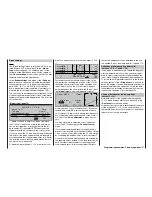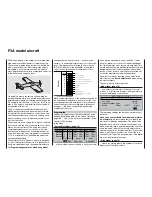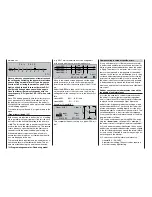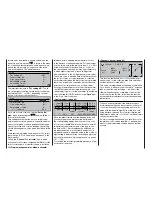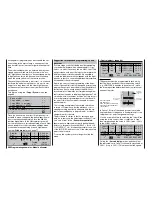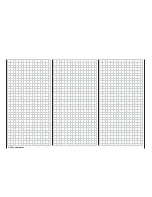
199
The actual helicopter-specifi c set-up is carried out pri-
marily in the menu ...
»Helicopter mixer« (page 122)
Pitch
Channel 1
Channel 1
Pitch ax.
0%
Gyro suppression
Swashplate rotation
«normal »
=>
=>
=>
0%
0%
0%
0%
0%
0°
Swashplate limiter
off
Throttle
Tail rot.
Tail rot.
Throttle
Throttle
Roll
Roll
Tail rot.
Throttle
Pitch ax.
Tail rot.
In the very fi rst line you will see the “Collective
pitch
”
function, and a brief press on the rotary control swit-
ches to the corresponding sub-menu. Here you will
fi nd a graph of the collective pitch curve, which is ini-
tially defi ned only by the three points “L” (low), “1” and
“H” (high); in most cases this is all you need.
Tip:
We strongly advise that you set up your helicopter
using just these three curve points; more points com-
plicate the whole matter, and at present are more
trouble than they are worth.
The reference point for hovering should generally be
the mechanical centre point of the collective pitch
stick, as this position feels most natural to the majori-
ty of pilots. You can, of course, set up the curve to lo-
cate the hover at a different point, but you should not
be tempted to do this unless you know exactly what
you are doing. Start by setting the collective pitch
stick to centre. Assuming that you previously adjusted
the servos in accordance with the manufacturer’s in-
structions, the servo output arms will now (usually) be
at right-angles to the servo case. If you have not al-
Programming examples: Model helicopter
ready done so, adjust the mechanical linkages to the
rotor head so that all the blades are set to a collective
pitch angle of 4° to 5° positive for the hover. All known
helicopters will fl y at approximately this setting.
Now move the collective pitch stick right back to the
maximum collective pitch point (the collective pitch
minimum position has already been defi ned as “for-
ward”). The solid vertical line in the graph indica-
tes the current stick position. You can now adjust this
point “H” (high) on the collective pitch curve using the
rotary control, with the aim of producing a collective
pitch maximum setting of around 9° at the main rotor
blades. Point “H” should be around 50%.
Note:
A rotor blade set-up gauge, e. g. the GRAUPNER
item, Order No.
61
, is very useful when setting up bla-
de pitch angles.
Now push the collective pitch stick fully forward to the
collective pitch minimum position: Point “L” (low). Set
the blade pitch angle for this setting to a value in the
range 0 to -4°, according to the pilot’s fl ying ability.
This process produces a slightly “bent” line (known as
the “collective pitch curve”) at the hover point, with the
result that the graph may look something like this:
?
1
+50%
+25%
m
OU
T
P
U
T
100
Pitch
Input
Curve
off
Point
Output
At this point you should round off the curve by simply
pressing the
ENTER
button again.
If you now switch to the auto-rotation phase – you will
see the name of the fl ight phase “Autorot” at the bot-
tom of the screen – you will fi nd the “old” collective
pitch curve once more. In this phase you should set
the same values as in the normal phase, with the fol-
lowing exception: increase the collective pitch angle
by about 2° at “H”, i. e. the extreme backward position
of the stick. This gives slightly more pitch for fl aring
the model when practising “autos” at a later (!) date.
Once you have set up the collective pitch curve, press
ESC
to return to the list of Helicopter Mixer menus.
Operate the auto-rotation switch to return to the “nor-
mal” fl ight phase, then move to the “
Channel 1
throttle
” line where you can set up the throttle curve.
The fi rst step here is to defi ne the idle trim range by
adjusting point “L” on the throttle curve; it should be
set to around -65%.
–65%
–65%
m
OU
T
P
U
T
--
+
1
100
–100%
L
Channel 1
Input
Curve
off
Point
Output
Throttle
With the throttle limiter
closed
and the idle trim fully
open, move the collective pitch stick to the “minimum”
position and move it slightly to and fro. The throttle
servo should not respond to this movement. This ar-
rangement gives you a seamless transition from idle
trim to the throttle curve. You will probably need to
make further adjustments to the throttle curve, but
this can only be carried out later as part of the fl ight-
testing process.
If you temporarily switch from the graphic screen to
the auto-rotation fl ight phase (AR), the following dis-
play appears:
Channel 1
Throttle
off
This means that this mixer is switched off, and the
Summary of Contents for mx-24s
Page 1: ...1...
Page 19: ...19 For your notes...
Page 35: ...35 For your notes...
Page 41: ...41 41 For your notes...
Page 57: ...57 For your notes...
Page 63: ...63 63 For your notes...
Page 69: ...69 69 For your notes...
Page 85: ...85 85 For your notes...
Page 99: ...99 For your notes...
Page 143: ...143 For your notes...
Page 191: ...191 For your notes...
Page 212: ...212 212 For your notes...
Page 213: ...213 213 For your notes...
Page 214: ...214 For your notes...
Page 216: ...216...



